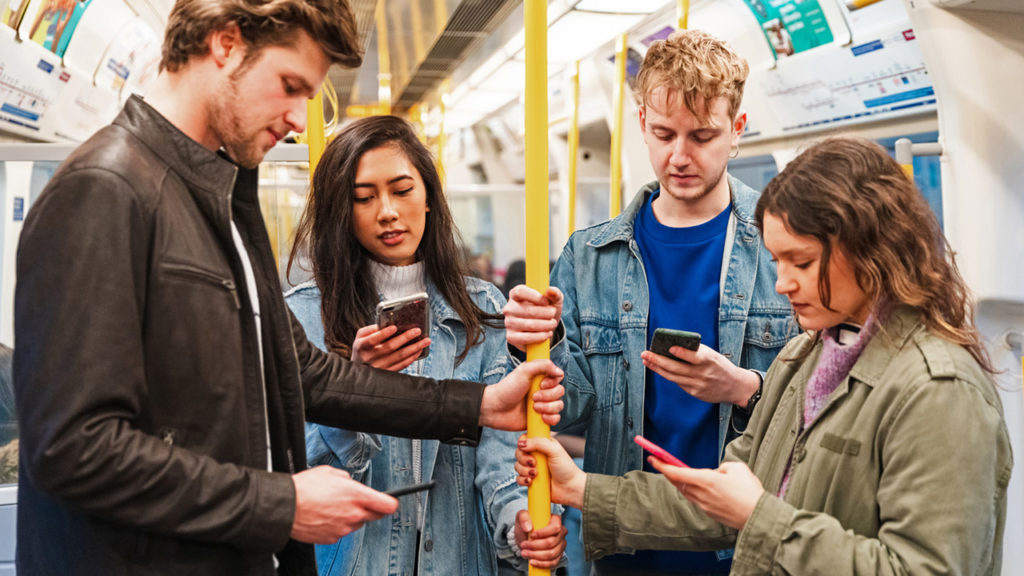Readers with longer memories will recall that when mobile telephony expanded in a big way during the mid-1980s, voice calling was the all-important factor. Being able to speak with others away from the home and office environment was a big step forward and the 1G analogue networks (Cellnet and Vodafone) took off exponentially. Radio masts appeared everywhere and coverage in excess of 90% was soon available. For the more difficult locations such as basements, sunken roads and especially tunnels, people just accepted that they would be unable to speak until they emerged into a more-open environment.
Starting with the digital 2G network and now advancing rapidly to 5G, data has overtaken voice as the more important connection with messaging, social media, video plus many business functions – finance, banking, ticketing, shopping and such like – all being demanded at the press of a button. No longer is it acceptable to be out-of-range, especially in busy urban areas.
For underground railways and many metros, this represents a considerable challenge as provision for public mobile radio usage in the early days was not considered important enough to justify the costs involved. Most railways of this type did invest in radio systems underground for operational and safety purposes, but the infrastructure – often with extensive radiating cable provision – was not designed to accommodate public radio networks.
The pressure is now on to change this and a talk given recently to the London & SE section of the IRSE looked at the challenges involved both from a technical and commercial aspect. The talk also considered the longer-term consequences of changes to radio technology, both internal to railway operations and the wider public.

The Jubilee Line trial
Setting the scene, Haider Gillani, who is the principal engineer for the Jubilee Line pilot project, and Dimitris Kaltakis, the senior radio engineer in TfL, outlined the objectives and scope of the project. The overall aim is to:
- implement the London Mayor’s strategy for public experience
- gain insight into customer radio usage
- increase knowledge of 4G operation
- trial cellular use on the Underground, including exploring radio use for other applications such as mission-critical messaging.
The chosen section of route has been the Jubilee Line eastwards from Westminster for eight stations, including the twin running tunnels. This is a busy section serving both Waterloo and London Bridge stations. The logistics for the infrastructure requirements were considerable:
- 32km of radiating cable with distributed antennae at stations
- two radiating cables required in each tunnel, with basestations feeding about 1km in each direction
- 16km of fibre cable
- 252 low-power basestations for stations
- 76 high-power basestations for the tunnels and platform areas
- some radio repeaters in the tunnels where basestation accommodation was problematic.
The architecture of the system includes a ‘basestation hotel’ from which all the distribution and aggregation is carried out, a Cat 5 structured cable network around all the station walkways to feed the multitude of antennae and the radiating cable containment within the tunnels. The latter are in metal trays either at the tunnel sides or sometimes in the roof.
Between 50 and 100 engineers were engaged in the installation and testing during engineering hours, taking place over several weeks. It must be remembered that the Jubilee Line is a deep-level tube and this section – whilst relatively new as it only opened at the time of the millennium and thus has slightly larger tunnels than earlier lines – is still very limited for space in the actual running tunnels.

Around 85,000GB of data was exchanged between March-October last year.
Results so far and challenges
The pilot is to run for 24 months, but is likely to continue in service beyond that time. All four of the MNOs (Mobile Network Operators – EE, Vodafone, Three and O2) have their system included in the trial – some on one cable, some on the other; as such, all mobile users can gain access.
Since commissioning, which took place just before the first Covid lockdown last year, performance and usage has been encouraging. By October, a reliability of 99.98% has been achieved and 85,000GB of data exchanged. The average person uses around 30Mb, with around 150Mbps cell throughput in station areas and 70Mbps in the tunnels. A clear indication of success emerges, even though ridership was reduced as a result of the pandemic.
Because of the environment, fire safety is vitally important and the LU standards are strict. This meant installing equipment and cabling in fireproof enclosures. Where mid-tunnel equipment was required, obtaining an enclosure within the available space envelope has been a real challenge. Some gaps in the radiating cable coverage were found and performance has been optimised since the trial started. The basestation ‘hotel’ is duplicated into two different rooms, but the heat generated underground was found to be a problem. The manufacturers of MNO equipment will need to recognise the importance of fire safety provision and will be required to make variants available to the standard product.
London Underground has other systems in the tunnel where interference might have been experienced. The principal concern was the LU CONNECT network provided by Thales in the 1990s to replace all existing transmission and radio systems with a fibre bearer, digital transmission and a TETRA-based operational radio network. To safeguard its integrity, the initial stance was to have a separation of 600mm between the 4G equipment and the CONNECT infrastructure. After some tests with Thales, a smaller distance was negotiated and even at 15mm, no interference was found. The Jubilee Line operates with the Thales Seltrac CBTC (Communications-Based Train Control) system and, again, testing had to be carried out to ensure no interference.
Exploring future radio predictions
Metros typically have not used GSM-R technology for their track-to-train communication requirements, with many – including LU – opting for TETRA. Haider Gillani indicated that having separate technology for metros in the future may not make economic sense. LU is aware that the move to standardise on the FRMCS (Future Rail Mobile Communication System) being developed by the UIC as a replacement for GSM-R may well be applicable.
With functionality due to be completed in 2022 and products available from 2024/5, pilot systems can expect to be deployed soon after that date. A key question will be the availability of dedicated spectrum, but indications are that 5.6MHz of bandwidth in the 900MHz band and 10MHz of bandwidth in the 1900MHz band could become available for rail purposes, although the latter is already in use by the EE mobile operator.
Having a single system for all purposes is a projected aim, but assurance on bearer agility, cyber security, spectrum availability and interoperability would need to be proven. The positive view is that applications could go right to the top of the safety-critical curve, including automation of trains, which has implications for the modernisation of rolling stock.
Deployment of such a system is already planned in Asia, notably Hong Kong and elsewhere in China, Seoul and India. In Europe, a full-scale trial took place on the Paris Metro Line 14 in 2016 over 3km of route using a private LTE (Long-Term Evolution) provider in the 2.6GHz band. This was integrated to include the provision of CBTC, CCTV and Passenger Information services. Other rail operators in America, Australia, Mexico, Canada and Brazil are all considering service convergence onto a single communications/radio network.
Emergency service provision
Providing radio coverage underground for the fire, police and ambulance services has to be considered in all of this. The Airwave TETRA system created following the King’s Cross fire and introduced from 2006 only really achieved connectivity between police forces in London. It was implemented on the CONNECT backbone and is now being replaced.
A new Emergency Services Network (ESN) in conjunction with the Home Office is being trialled by Frequentis, an Austrian company well known in the UK for radio system provision associated with air traffic control, rail and police networks. The new network will interface with the Airwave system until such time as full changeover has taken place; it will also cover the ambulance service. The design is a LTE network, built to mission-critical 3GPP standards, and clearly there are opportunities for integration with any 4G network that LU progresses.
Piccadilly Line implications
For the forthcoming Piccadilly Line upgrade, the lessons from the 4G trial are being carefully studied, so says Robert Frith, the Head of Engineering for the Piccadilly Line project. Initially, the upgrade will be the purchase of 94 new trains with the intention of achieving a 27 trains per hour (tph) service in the peak, but using the existing signalling. More significantly, a second phase will see the line being equipped with CBTC to give up to 36 tph, a single new control centre, 145km of digital signalling and an additional 15 trains. Details for the project’s engineering have yet to be firmed up, but with the possibility of having a 4G/5G bearer in place, consideration is being given as to whether this could support all the necessary requirements, including mission-critical services.
For this to be feasible, it would be necessary for the communication networks to be separated contractually from the signalling system. Both underground and open-air sections of line would need to be covered. LU is understandably cautious and would need to be assured that a 4G LTE network that they might not fully control would be suitable as the prime communications bearer. Obtaining a system safety case is viewed as a challenge. The alternative would be to employ it as a secondary mode and use for:
- live rolling stock and infrastructure diagnostics
- the potential to combine with UWB (Ultra Wide Band) technology
- facilitation of CCTV, passenger information and line control comms.
A move towards greater industry standardisation and modularisation of the proposed signalling assets would be welcome and could influence the decision.
In summary
The need to provide reliable data communication to the public is seen as essential and extending the trial on the Jubilee Line to all of London Underground will become policy. Whether a common single bearer will be a practical proposition remains to be decided, given the safety implications of rail operations. The migration to FRMCS will be a possibility once this becomes an international standard from 2025. Alignment with signalling renewals will be a consideration to take advantage of the bandwidth availability from a 4G network. In time, the CONNECT network will migrate to the new 4G network.
There are some fascinating options for LU to be decided in the next 3-4 years, but it is good that serious thought is being given to the different radio requirements.

